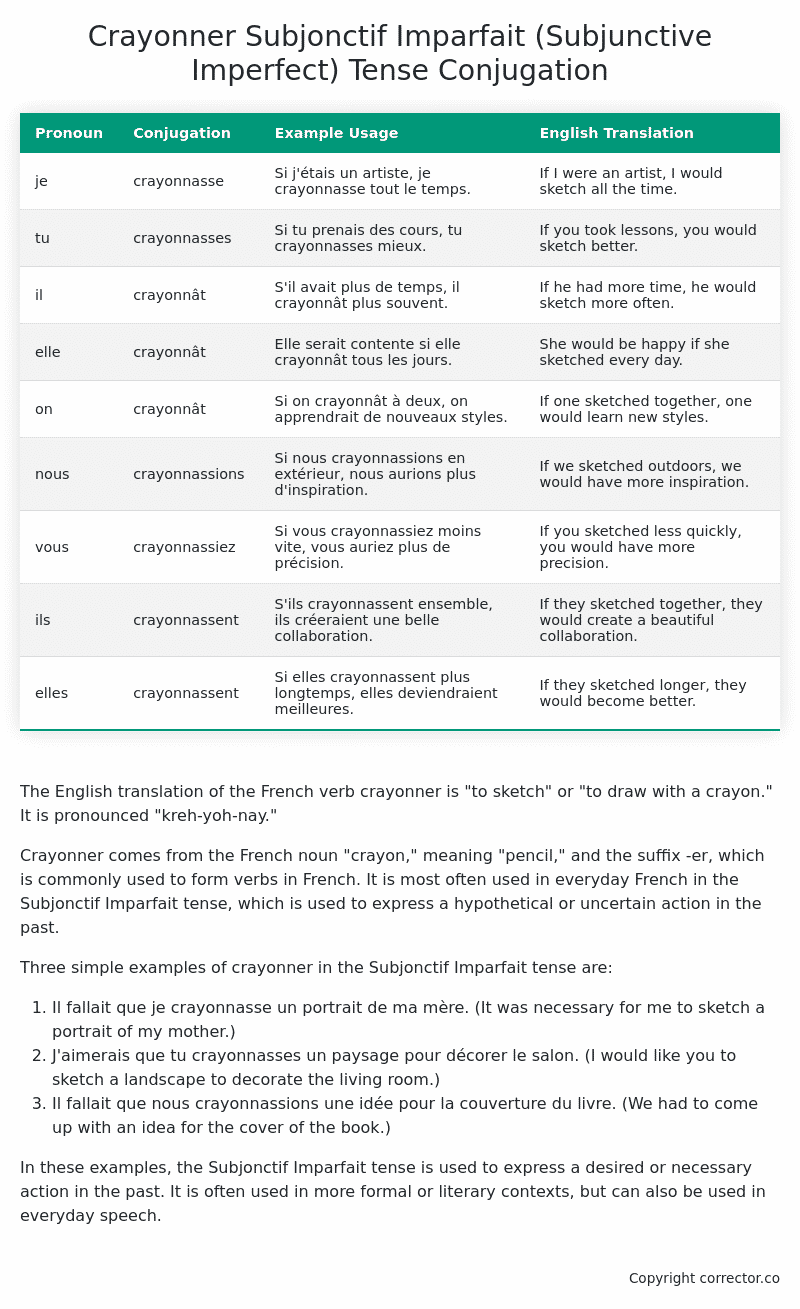Subjonctif Imparfait (Subjunctive Imperfect) Tense Conjugation of the French Verb crayonner
Introduction to the verb crayonner
The English translation of the French verb crayonner is “to sketch” or “to draw with a crayon.” It is pronounced “kreh-yoh-nay.”
Crayonner comes from the French noun “crayon,” meaning “pencil,” and the suffix -er, which is commonly used to form verbs in French. It is most often used in everyday French in the Subjonctif Imparfait tense, which is used to express a hypothetical or uncertain action in the past.
Three simple examples of crayonner in the Subjonctif Imparfait tense are:
- Il fallait que je crayonnasse un portrait de ma mère. (It was necessary for me to sketch a portrait of my mother.)
- J’aimerais que tu crayonnasses un paysage pour décorer le salon. (I would like you to sketch a landscape to decorate the living room.)
- Il fallait que nous crayonnassions une idée pour la couverture du livre. (We had to come up with an idea for the cover of the book.)
In these examples, the Subjonctif Imparfait tense is used to express a desired or necessary action in the past. It is often used in more formal or literary contexts, but can also be used in everyday speech.
Table of the Subjonctif Imparfait (Subjunctive Imperfect) Tense Conjugation of crayonner
| Pronoun | Conjugation | Example Usage | English Translation |
|---|---|---|---|
| je | crayonnasse | Si j’étais un artiste, je crayonnasse tout le temps. | If I were an artist, I would sketch all the time. |
| tu | crayonnasses | Si tu prenais des cours, tu crayonnasses mieux. | If you took lessons, you would sketch better. |
| il | crayonnât | S’il avait plus de temps, il crayonnât plus souvent. | If he had more time, he would sketch more often. |
| elle | crayonnât | Elle serait contente si elle crayonnât tous les jours. | She would be happy if she sketched every day. |
| on | crayonnât | Si on crayonnât à deux, on apprendrait de nouveaux styles. | If one sketched together, one would learn new styles. |
| nous | crayonnassions | Si nous crayonnassions en extérieur, nous aurions plus d’inspiration. | If we sketched outdoors, we would have more inspiration. |
| vous | crayonnassiez | Si vous crayonnassiez moins vite, vous auriez plus de précision. | If you sketched less quickly, you would have more precision. |
| ils | crayonnassent | S’ils crayonnassent ensemble, ils créeraient une belle collaboration. | If they sketched together, they would create a beautiful collaboration. |
| elles | crayonnassent | Si elles crayonnassent plus longtemps, elles deviendraient meilleures. | If they sketched longer, they would become better. |
Other Conjugations for Crayonner.
Le Present (Present Tense) Conjugation of the French Verb crayonner
Imparfait (Imperfect) Tense Conjugation of the French Verb crayonner
Passé Simple (Simple Past) Tense Conjugation of the French Verb crayonner
Passé Composé (Present Perfect) Tense Conjugation of the French Verb crayonner
Futur Simple (Simple Future) Tense Conjugation of the French Verb crayonner
Futur Proche (Near Future) Tense Conjugation of the French Verb crayonner
Plus-que-parfait (Pluperfect) Tense Conjugation of the French Verb crayonner
Passé Antérieur (Past Anterior) Tense Conjugation of the French Verb crayonner
Futur Antérieur (Future Anterior) Tense Conjugation of the French Verb crayonner
Subjonctif Présent (Subjunctive Present) Tense Conjugation of the French Verb crayonner
Subjonctif Passé (Subjunctive Past) Tense Conjugation of the French Verb crayonner
Subjonctif Imparfait (Subjunctive Imperfect) Tense Conjugation of the French Verb crayonner (this article)
Subjonctif Plus-que-parfait (Subjunctive Pluperfect) Tense Conjugation of the French Verb crayonner
Conditionnel Présent (Conditional Present) Tense Conjugation of the French Verb crayonner
Conditionnel Passé (Conditional Past) Tense Conjugation of the French Verb crayonner
L’impératif Présent (Imperative Present) Tense Conjugation of the French Verb crayonner
L’infinitif Présent (Infinitive Present) Tense Conjugation of the French Verb crayonner
Struggling with French verbs or the language in general? Why not use our free French Grammar Checker – no registration required!
Get a FREE Download Study Sheet of this Conjugation 🔥
Simply right click the image below, click “save image” and get your free reference for the crayonner Subjonctif Imparfait tense conjugation!

Crayonner – About the French Subjonctif Imparfait (Subjunctive Imperfect) Tense
Formation
Common Everyday Usage Patterns
Interactions with Other Tenses
Subjonctif Présent
Indicatif Passé Composé
Conditional
Conditional Perfect
Summary
I hope you enjoyed this article on the verb crayonner. Still in a learning mood? Check out another TOTALLY random French verb conjugation!


